Thomas Cook: Management Styles, Structure, and Organizational Culture
VerifiedAdded on 2023/01/11
|10
|3940
|96
Report
AI Summary
This report examines the organizational theory and practice at Thomas Cook, focusing on the management styles employed by the CEO, particularly directive and authoritative approaches. It analyzes the organizational structure, specifically the functional structure, and its impact on achieving high performance, along with the company's clan culture and its effects on employees. The report further explores the leadership styles of the CEO, emphasizing the importance of leadership in enhancing organizational effectiveness, including autocratic and democratic leadership styles. Additionally, it discusses the effects of power, influence, and conflict within the organization, and the various types of motivation used by Thomas Cook to engage its employees, providing a comprehensive overview of the company's operational and management strategies.
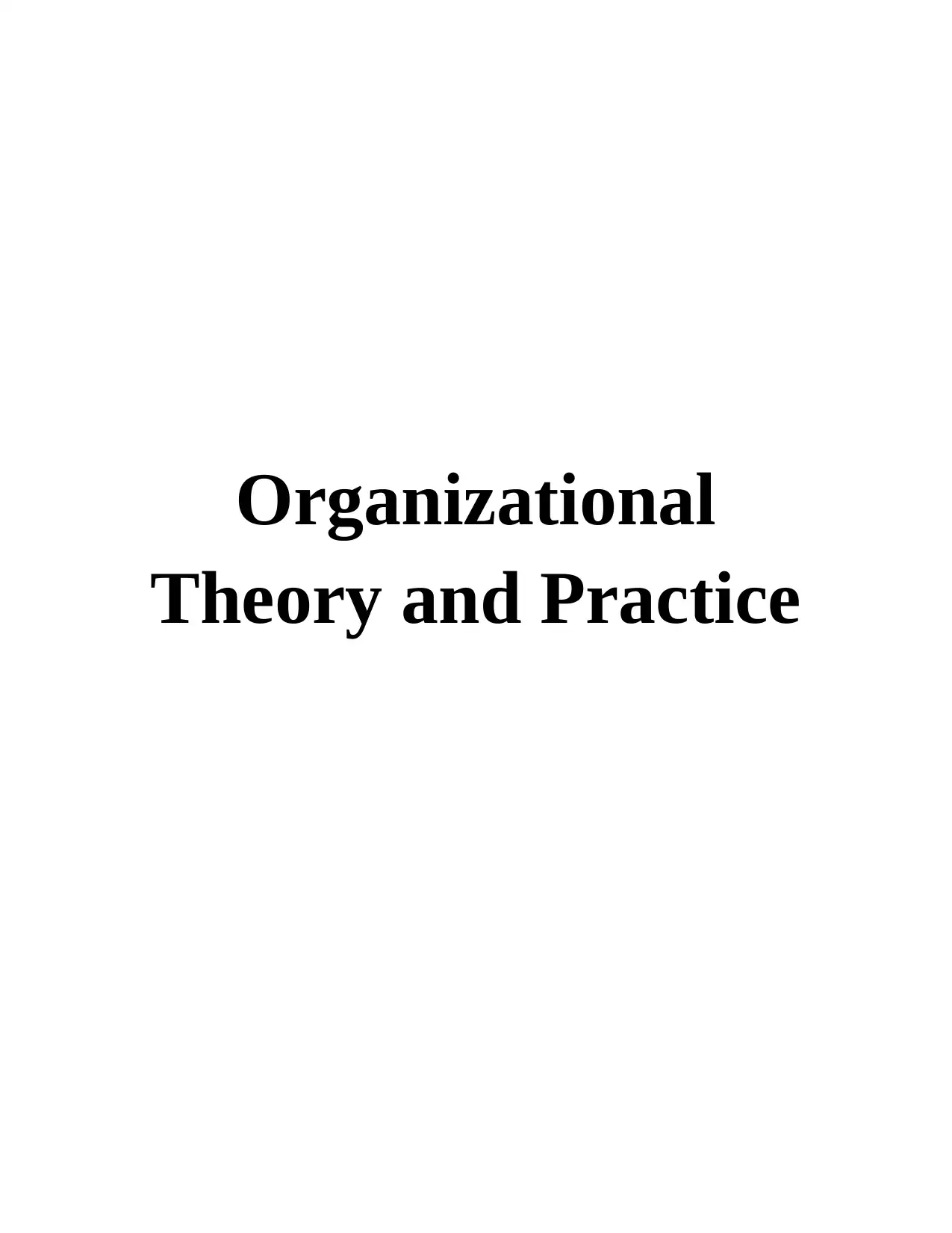
Organizational
Theory and Practice
Theory and Practice
Paraphrase This Document
Need a fresh take? Get an instant paraphrase of this document with our AI Paraphraser
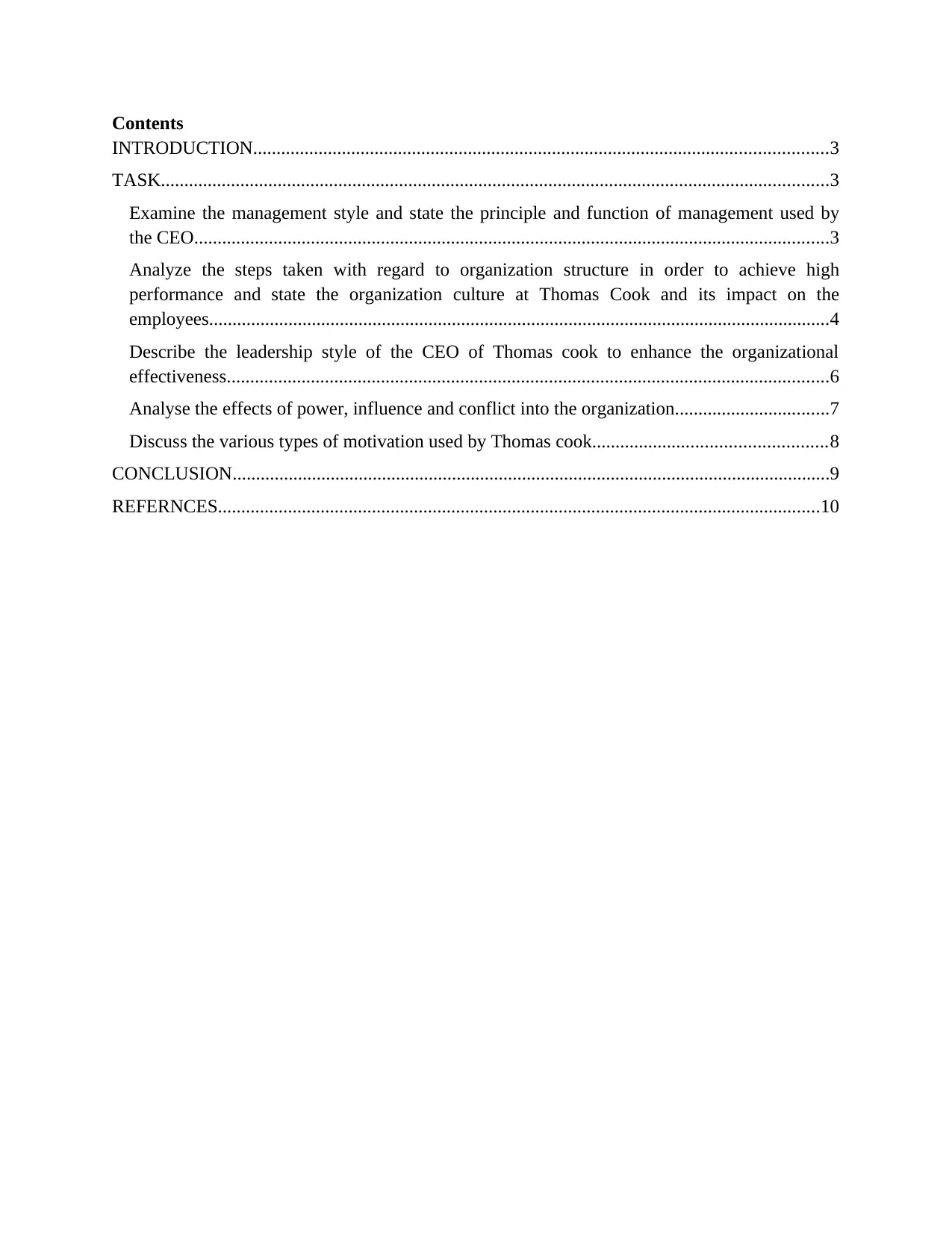
Contents
INTRODUCTION...........................................................................................................................3
TASK...............................................................................................................................................3
Examine the management style and state the principle and function of management used by
the CEO........................................................................................................................................3
Analyze the steps taken with regard to organization structure in order to achieve high
performance and state the organization culture at Thomas Cook and its impact on the
employees.....................................................................................................................................4
Describe the leadership style of the CEO of Thomas cook to enhance the organizational
effectiveness.................................................................................................................................6
Analyse the effects of power, influence and conflict into the organization.................................7
Discuss the various types of motivation used by Thomas cook..................................................8
CONCLUSION................................................................................................................................9
REFERNCES.................................................................................................................................10
INTRODUCTION...........................................................................................................................3
TASK...............................................................................................................................................3
Examine the management style and state the principle and function of management used by
the CEO........................................................................................................................................3
Analyze the steps taken with regard to organization structure in order to achieve high
performance and state the organization culture at Thomas Cook and its impact on the
employees.....................................................................................................................................4
Describe the leadership style of the CEO of Thomas cook to enhance the organizational
effectiveness.................................................................................................................................6
Analyse the effects of power, influence and conflict into the organization.................................7
Discuss the various types of motivation used by Thomas cook..................................................8
CONCLUSION................................................................................................................................9
REFERNCES.................................................................................................................................10
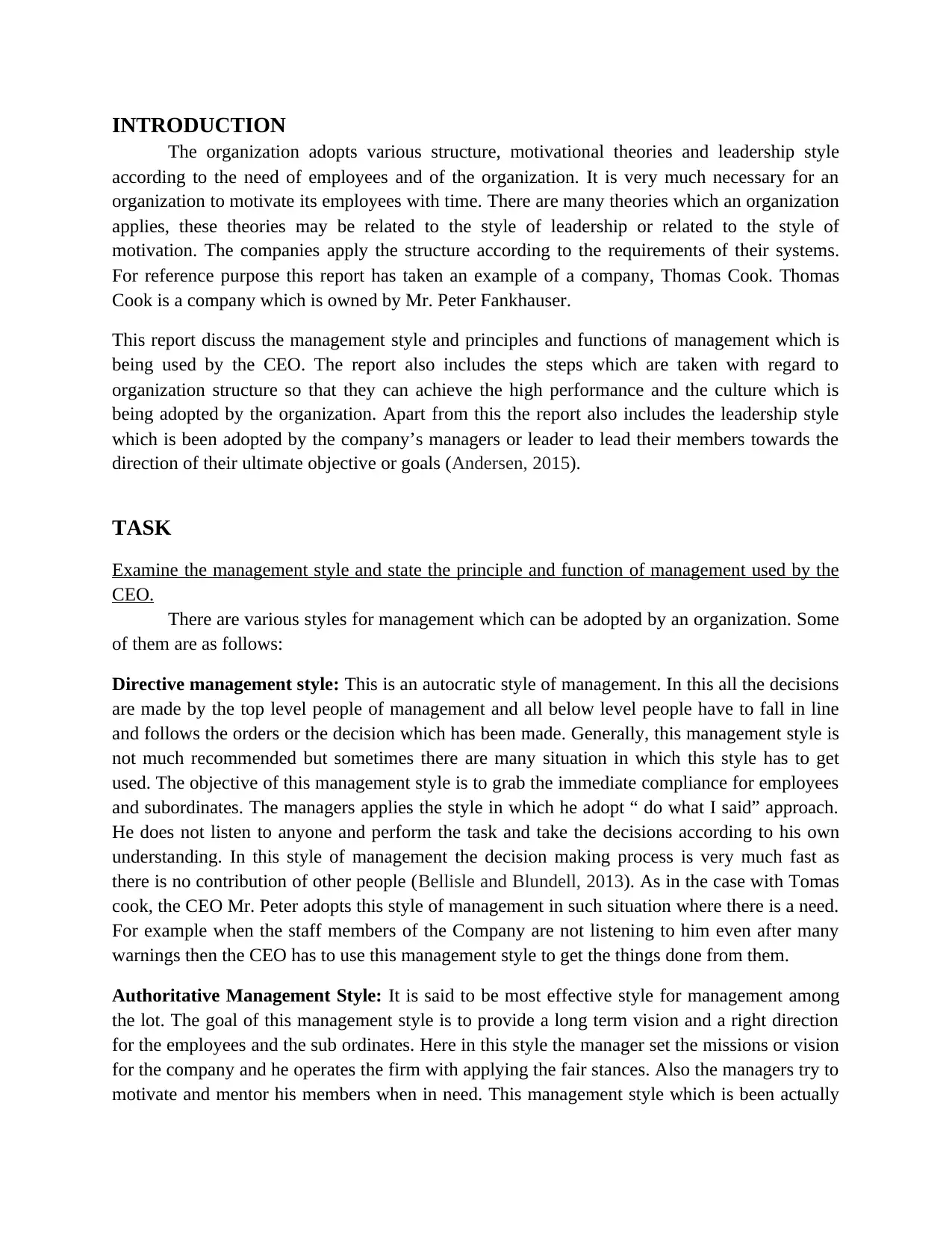
INTRODUCTION
The organization adopts various structure, motivational theories and leadership style
according to the need of employees and of the organization. It is very much necessary for an
organization to motivate its employees with time. There are many theories which an organization
applies, these theories may be related to the style of leadership or related to the style of
motivation. The companies apply the structure according to the requirements of their systems.
For reference purpose this report has taken an example of a company, Thomas Cook. Thomas
Cook is a company which is owned by Mr. Peter Fankhauser.
This report discuss the management style and principles and functions of management which is
being used by the CEO. The report also includes the steps which are taken with regard to
organization structure so that they can achieve the high performance and the culture which is
being adopted by the organization. Apart from this the report also includes the leadership style
which is been adopted by the company’s managers or leader to lead their members towards the
direction of their ultimate objective or goals (Andersen, 2015).
TASK
Examine the management style and state the principle and function of management used by the
CEO.
There are various styles for management which can be adopted by an organization. Some
of them are as follows:
Directive management style: This is an autocratic style of management. In this all the decisions
are made by the top level people of management and all below level people have to fall in line
and follows the orders or the decision which has been made. Generally, this management style is
not much recommended but sometimes there are many situation in which this style has to get
used. The objective of this management style is to grab the immediate compliance for employees
and subordinates. The managers applies the style in which he adopt “ do what I said” approach.
He does not listen to anyone and perform the task and take the decisions according to his own
understanding. In this style of management the decision making process is very much fast as
there is no contribution of other people (Bellisle and Blundell, 2013). As in the case with Tomas
cook, the CEO Mr. Peter adopts this style of management in such situation where there is a need.
For example when the staff members of the Company are not listening to him even after many
warnings then the CEO has to use this management style to get the things done from them.
Authoritative Management Style: It is said to be most effective style for management among
the lot. The goal of this management style is to provide a long term vision and a right direction
for the employees and the sub ordinates. Here in this style the manager set the missions or vision
for the company and he operates the firm with applying the fair stances. Also the managers try to
motivate and mentor his members when in need. This management style which is been actually
The organization adopts various structure, motivational theories and leadership style
according to the need of employees and of the organization. It is very much necessary for an
organization to motivate its employees with time. There are many theories which an organization
applies, these theories may be related to the style of leadership or related to the style of
motivation. The companies apply the structure according to the requirements of their systems.
For reference purpose this report has taken an example of a company, Thomas Cook. Thomas
Cook is a company which is owned by Mr. Peter Fankhauser.
This report discuss the management style and principles and functions of management which is
being used by the CEO. The report also includes the steps which are taken with regard to
organization structure so that they can achieve the high performance and the culture which is
being adopted by the organization. Apart from this the report also includes the leadership style
which is been adopted by the company’s managers or leader to lead their members towards the
direction of their ultimate objective or goals (Andersen, 2015).
TASK
Examine the management style and state the principle and function of management used by the
CEO.
There are various styles for management which can be adopted by an organization. Some
of them are as follows:
Directive management style: This is an autocratic style of management. In this all the decisions
are made by the top level people of management and all below level people have to fall in line
and follows the orders or the decision which has been made. Generally, this management style is
not much recommended but sometimes there are many situation in which this style has to get
used. The objective of this management style is to grab the immediate compliance for employees
and subordinates. The managers applies the style in which he adopt “ do what I said” approach.
He does not listen to anyone and perform the task and take the decisions according to his own
understanding. In this style of management the decision making process is very much fast as
there is no contribution of other people (Bellisle and Blundell, 2013). As in the case with Tomas
cook, the CEO Mr. Peter adopts this style of management in such situation where there is a need.
For example when the staff members of the Company are not listening to him even after many
warnings then the CEO has to use this management style to get the things done from them.
Authoritative Management Style: It is said to be most effective style for management among
the lot. The goal of this management style is to provide a long term vision and a right direction
for the employees and the sub ordinates. Here in this style the manager set the missions or vision
for the company and he operates the firm with applying the fair stances. Also the managers try to
motivate and mentor his members when in need. This management style which is been actually
⊘ This is a preview!⊘
Do you want full access?
Subscribe today to unlock all pages.

Trusted by 1+ million students worldwide
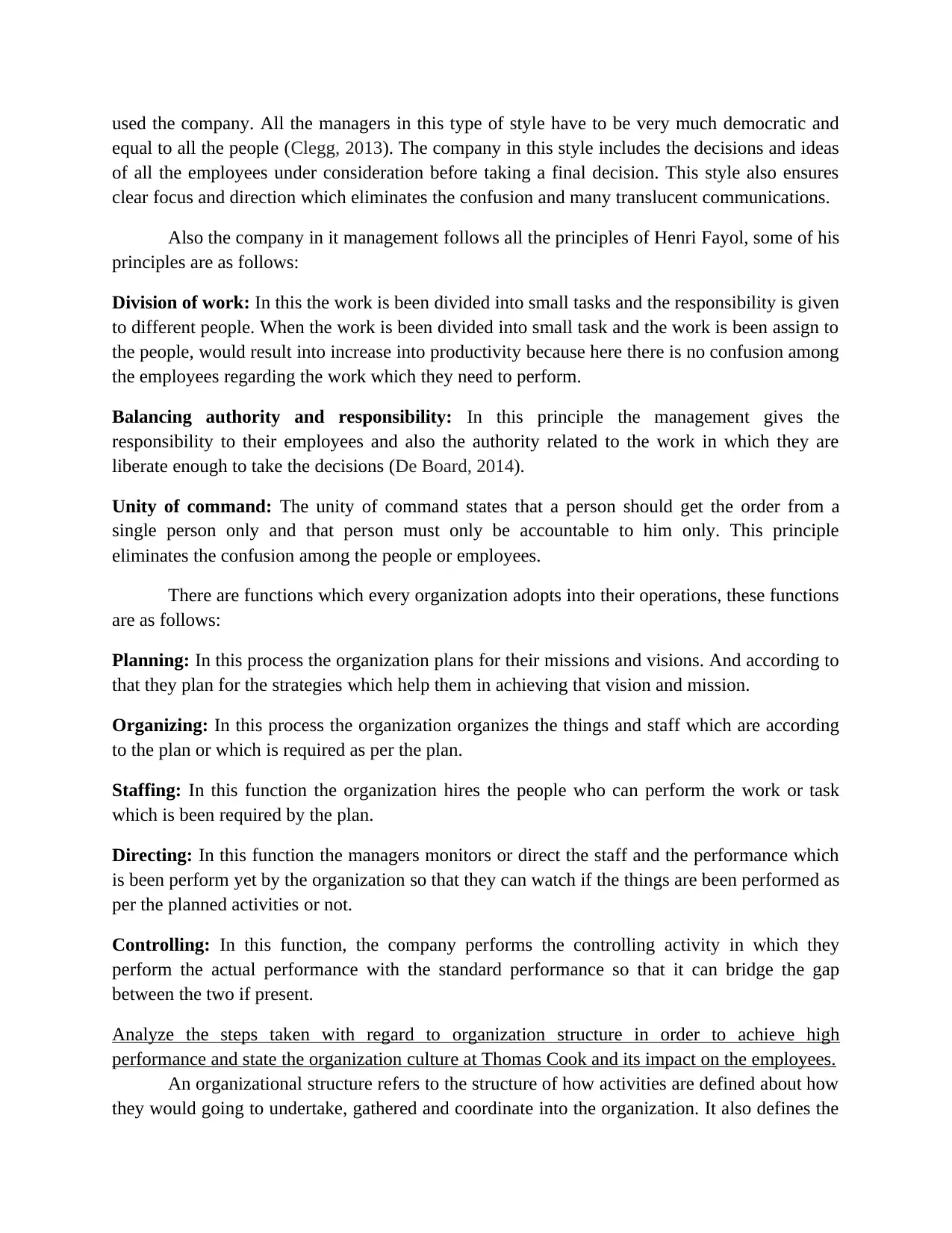
used the company. All the managers in this type of style have to be very much democratic and
equal to all the people (Clegg, 2013). The company in this style includes the decisions and ideas
of all the employees under consideration before taking a final decision. This style also ensures
clear focus and direction which eliminates the confusion and many translucent communications.
Also the company in it management follows all the principles of Henri Fayol, some of his
principles are as follows:
Division of work: In this the work is been divided into small tasks and the responsibility is given
to different people. When the work is been divided into small task and the work is been assign to
the people, would result into increase into productivity because here there is no confusion among
the employees regarding the work which they need to perform.
Balancing authority and responsibility: In this principle the management gives the
responsibility to their employees and also the authority related to the work in which they are
liberate enough to take the decisions (De Board, 2014).
Unity of command: The unity of command states that a person should get the order from a
single person only and that person must only be accountable to him only. This principle
eliminates the confusion among the people or employees.
There are functions which every organization adopts into their operations, these functions
are as follows:
Planning: In this process the organization plans for their missions and visions. And according to
that they plan for the strategies which help them in achieving that vision and mission.
Organizing: In this process the organization organizes the things and staff which are according
to the plan or which is required as per the plan.
Staffing: In this function the organization hires the people who can perform the work or task
which is been required by the plan.
Directing: In this function the managers monitors or direct the staff and the performance which
is been perform yet by the organization so that they can watch if the things are been performed as
per the planned activities or not.
Controlling: In this function, the company performs the controlling activity in which they
perform the actual performance with the standard performance so that it can bridge the gap
between the two if present.
Analyze the steps taken with regard to organization structure in order to achieve high
performance and state the organization culture at Thomas Cook and its impact on the employees.
An organizational structure refers to the structure of how activities are defined about how
they would going to undertake, gathered and coordinate into the organization. It also defines the
equal to all the people (Clegg, 2013). The company in this style includes the decisions and ideas
of all the employees under consideration before taking a final decision. This style also ensures
clear focus and direction which eliminates the confusion and many translucent communications.
Also the company in it management follows all the principles of Henri Fayol, some of his
principles are as follows:
Division of work: In this the work is been divided into small tasks and the responsibility is given
to different people. When the work is been divided into small task and the work is been assign to
the people, would result into increase into productivity because here there is no confusion among
the employees regarding the work which they need to perform.
Balancing authority and responsibility: In this principle the management gives the
responsibility to their employees and also the authority related to the work in which they are
liberate enough to take the decisions (De Board, 2014).
Unity of command: The unity of command states that a person should get the order from a
single person only and that person must only be accountable to him only. This principle
eliminates the confusion among the people or employees.
There are functions which every organization adopts into their operations, these functions
are as follows:
Planning: In this process the organization plans for their missions and visions. And according to
that they plan for the strategies which help them in achieving that vision and mission.
Organizing: In this process the organization organizes the things and staff which are according
to the plan or which is required as per the plan.
Staffing: In this function the organization hires the people who can perform the work or task
which is been required by the plan.
Directing: In this function the managers monitors or direct the staff and the performance which
is been perform yet by the organization so that they can watch if the things are been performed as
per the planned activities or not.
Controlling: In this function, the company performs the controlling activity in which they
perform the actual performance with the standard performance so that it can bridge the gap
between the two if present.
Analyze the steps taken with regard to organization structure in order to achieve high
performance and state the organization culture at Thomas Cook and its impact on the employees.
An organizational structure refers to the structure of how activities are defined about how
they would going to undertake, gathered and coordinate into the organization. It also defines the
Paraphrase This Document
Need a fresh take? Get an instant paraphrase of this document with our AI Paraphraser
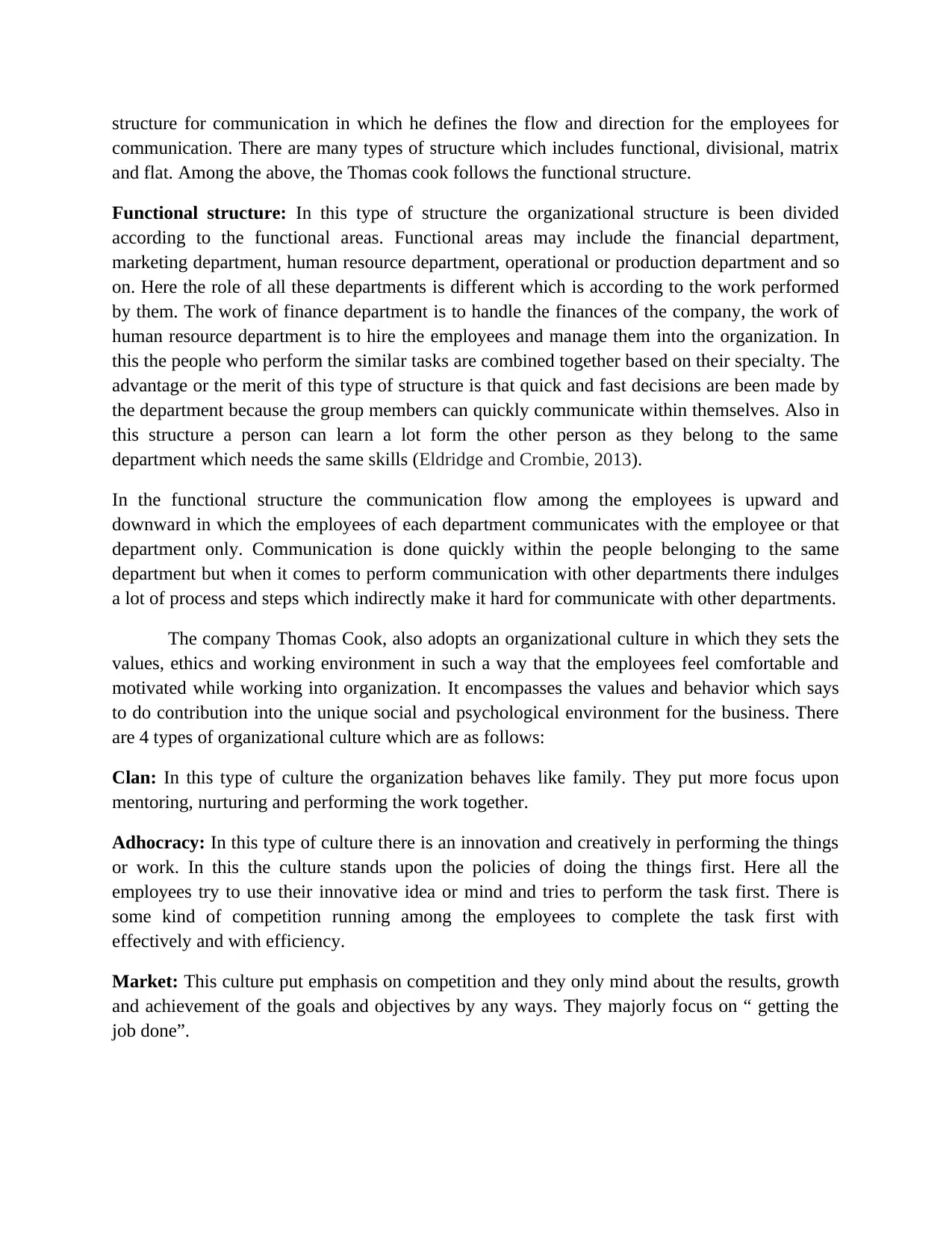
structure for communication in which he defines the flow and direction for the employees for
communication. There are many types of structure which includes functional, divisional, matrix
and flat. Among the above, the Thomas cook follows the functional structure.
Functional structure: In this type of structure the organizational structure is been divided
according to the functional areas. Functional areas may include the financial department,
marketing department, human resource department, operational or production department and so
on. Here the role of all these departments is different which is according to the work performed
by them. The work of finance department is to handle the finances of the company, the work of
human resource department is to hire the employees and manage them into the organization. In
this the people who perform the similar tasks are combined together based on their specialty. The
advantage or the merit of this type of structure is that quick and fast decisions are been made by
the department because the group members can quickly communicate within themselves. Also in
this structure a person can learn a lot form the other person as they belong to the same
department which needs the same skills (Eldridge and Crombie, 2013).
In the functional structure the communication flow among the employees is upward and
downward in which the employees of each department communicates with the employee or that
department only. Communication is done quickly within the people belonging to the same
department but when it comes to perform communication with other departments there indulges
a lot of process and steps which indirectly make it hard for communicate with other departments.
The company Thomas Cook, also adopts an organizational culture in which they sets the
values, ethics and working environment in such a way that the employees feel comfortable and
motivated while working into organization. It encompasses the values and behavior which says
to do contribution into the unique social and psychological environment for the business. There
are 4 types of organizational culture which are as follows:
Clan: In this type of culture the organization behaves like family. They put more focus upon
mentoring, nurturing and performing the work together.
Adhocracy: In this type of culture there is an innovation and creatively in performing the things
or work. In this the culture stands upon the policies of doing the things first. Here all the
employees try to use their innovative idea or mind and tries to perform the task first. There is
some kind of competition running among the employees to complete the task first with
effectively and with efficiency.
Market: This culture put emphasis on competition and they only mind about the results, growth
and achievement of the goals and objectives by any ways. They majorly focus on “ getting the
job done”.
communication. There are many types of structure which includes functional, divisional, matrix
and flat. Among the above, the Thomas cook follows the functional structure.
Functional structure: In this type of structure the organizational structure is been divided
according to the functional areas. Functional areas may include the financial department,
marketing department, human resource department, operational or production department and so
on. Here the role of all these departments is different which is according to the work performed
by them. The work of finance department is to handle the finances of the company, the work of
human resource department is to hire the employees and manage them into the organization. In
this the people who perform the similar tasks are combined together based on their specialty. The
advantage or the merit of this type of structure is that quick and fast decisions are been made by
the department because the group members can quickly communicate within themselves. Also in
this structure a person can learn a lot form the other person as they belong to the same
department which needs the same skills (Eldridge and Crombie, 2013).
In the functional structure the communication flow among the employees is upward and
downward in which the employees of each department communicates with the employee or that
department only. Communication is done quickly within the people belonging to the same
department but when it comes to perform communication with other departments there indulges
a lot of process and steps which indirectly make it hard for communicate with other departments.
The company Thomas Cook, also adopts an organizational culture in which they sets the
values, ethics and working environment in such a way that the employees feel comfortable and
motivated while working into organization. It encompasses the values and behavior which says
to do contribution into the unique social and psychological environment for the business. There
are 4 types of organizational culture which are as follows:
Clan: In this type of culture the organization behaves like family. They put more focus upon
mentoring, nurturing and performing the work together.
Adhocracy: In this type of culture there is an innovation and creatively in performing the things
or work. In this the culture stands upon the policies of doing the things first. Here all the
employees try to use their innovative idea or mind and tries to perform the task first. There is
some kind of competition running among the employees to complete the task first with
effectively and with efficiency.
Market: This culture put emphasis on competition and they only mind about the results, growth
and achievement of the goals and objectives by any ways. They majorly focus on “ getting the
job done”.
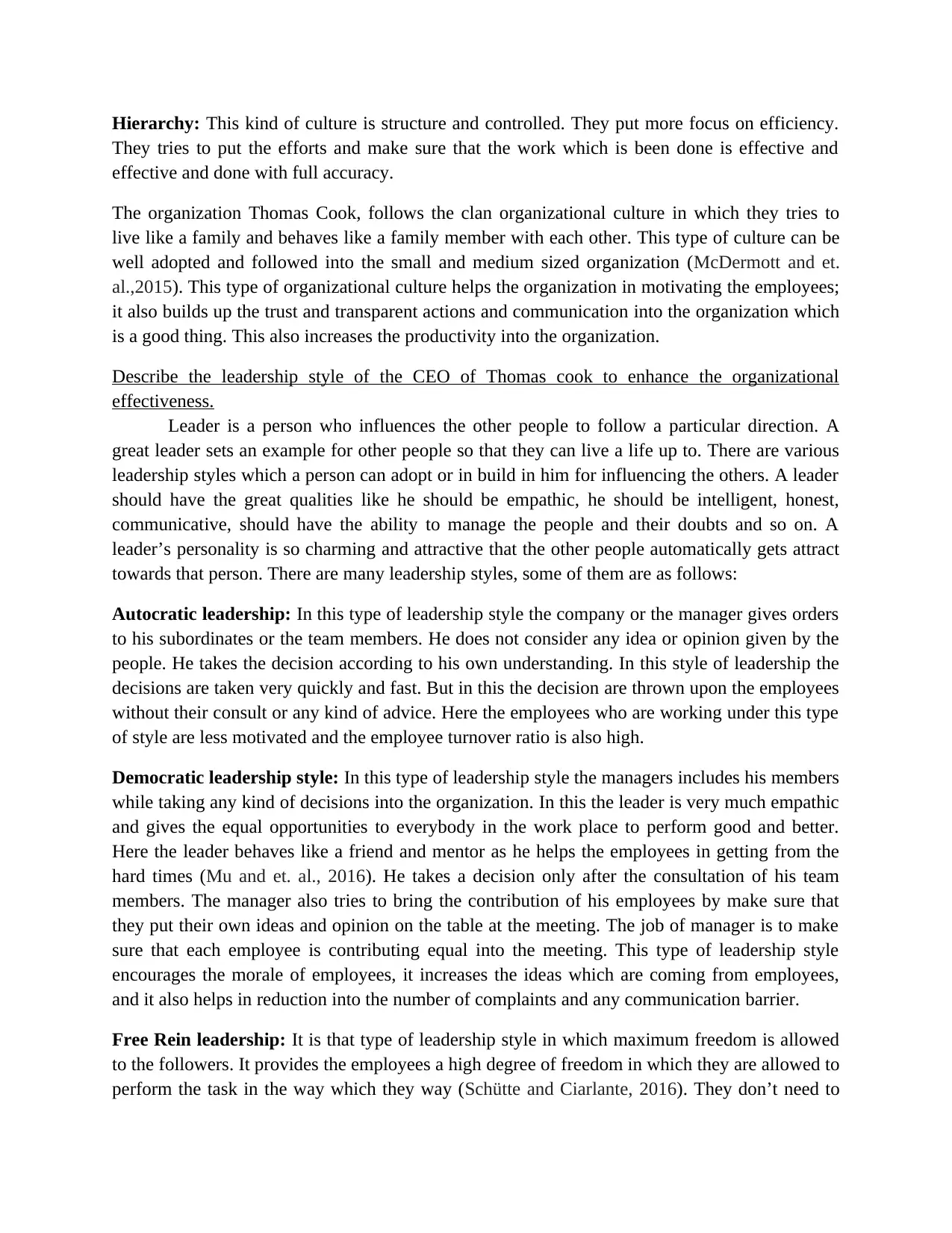
Hierarchy: This kind of culture is structure and controlled. They put more focus on efficiency.
They tries to put the efforts and make sure that the work which is been done is effective and
effective and done with full accuracy.
The organization Thomas Cook, follows the clan organizational culture in which they tries to
live like a family and behaves like a family member with each other. This type of culture can be
well adopted and followed into the small and medium sized organization (McDermott and et.
al.,2015). This type of organizational culture helps the organization in motivating the employees;
it also builds up the trust and transparent actions and communication into the organization which
is a good thing. This also increases the productivity into the organization.
Describe the leadership style of the CEO of Thomas cook to enhance the organizational
effectiveness.
Leader is a person who influences the other people to follow a particular direction. A
great leader sets an example for other people so that they can live a life up to. There are various
leadership styles which a person can adopt or in build in him for influencing the others. A leader
should have the great qualities like he should be empathic, he should be intelligent, honest,
communicative, should have the ability to manage the people and their doubts and so on. A
leader’s personality is so charming and attractive that the other people automatically gets attract
towards that person. There are many leadership styles, some of them are as follows:
Autocratic leadership: In this type of leadership style the company or the manager gives orders
to his subordinates or the team members. He does not consider any idea or opinion given by the
people. He takes the decision according to his own understanding. In this style of leadership the
decisions are taken very quickly and fast. But in this the decision are thrown upon the employees
without their consult or any kind of advice. Here the employees who are working under this type
of style are less motivated and the employee turnover ratio is also high.
Democratic leadership style: In this type of leadership style the managers includes his members
while taking any kind of decisions into the organization. In this the leader is very much empathic
and gives the equal opportunities to everybody in the work place to perform good and better.
Here the leader behaves like a friend and mentor as he helps the employees in getting from the
hard times (Mu and et. al., 2016). He takes a decision only after the consultation of his team
members. The manager also tries to bring the contribution of his employees by make sure that
they put their own ideas and opinion on the table at the meeting. The job of manager is to make
sure that each employee is contributing equal into the meeting. This type of leadership style
encourages the morale of employees, it increases the ideas which are coming from employees,
and it also helps in reduction into the number of complaints and any communication barrier.
Free Rein leadership: It is that type of leadership style in which maximum freedom is allowed
to the followers. It provides the employees a high degree of freedom in which they are allowed to
perform the task in the way which they way (Schütte and Ciarlante, 2016). They don’t need to
They tries to put the efforts and make sure that the work which is been done is effective and
effective and done with full accuracy.
The organization Thomas Cook, follows the clan organizational culture in which they tries to
live like a family and behaves like a family member with each other. This type of culture can be
well adopted and followed into the small and medium sized organization (McDermott and et.
al.,2015). This type of organizational culture helps the organization in motivating the employees;
it also builds up the trust and transparent actions and communication into the organization which
is a good thing. This also increases the productivity into the organization.
Describe the leadership style of the CEO of Thomas cook to enhance the organizational
effectiveness.
Leader is a person who influences the other people to follow a particular direction. A
great leader sets an example for other people so that they can live a life up to. There are various
leadership styles which a person can adopt or in build in him for influencing the others. A leader
should have the great qualities like he should be empathic, he should be intelligent, honest,
communicative, should have the ability to manage the people and their doubts and so on. A
leader’s personality is so charming and attractive that the other people automatically gets attract
towards that person. There are many leadership styles, some of them are as follows:
Autocratic leadership: In this type of leadership style the company or the manager gives orders
to his subordinates or the team members. He does not consider any idea or opinion given by the
people. He takes the decision according to his own understanding. In this style of leadership the
decisions are taken very quickly and fast. But in this the decision are thrown upon the employees
without their consult or any kind of advice. Here the employees who are working under this type
of style are less motivated and the employee turnover ratio is also high.
Democratic leadership style: In this type of leadership style the managers includes his members
while taking any kind of decisions into the organization. In this the leader is very much empathic
and gives the equal opportunities to everybody in the work place to perform good and better.
Here the leader behaves like a friend and mentor as he helps the employees in getting from the
hard times (Mu and et. al., 2016). He takes a decision only after the consultation of his team
members. The manager also tries to bring the contribution of his employees by make sure that
they put their own ideas and opinion on the table at the meeting. The job of manager is to make
sure that each employee is contributing equal into the meeting. This type of leadership style
encourages the morale of employees, it increases the ideas which are coming from employees,
and it also helps in reduction into the number of complaints and any communication barrier.
Free Rein leadership: It is that type of leadership style in which maximum freedom is allowed
to the followers. It provides the employees a high degree of freedom in which they are allowed to
perform the task in the way which they way (Schütte and Ciarlante, 2016). They don’t need to
⊘ This is a preview!⊘
Do you want full access?
Subscribe today to unlock all pages.

Trusted by 1+ million students worldwide
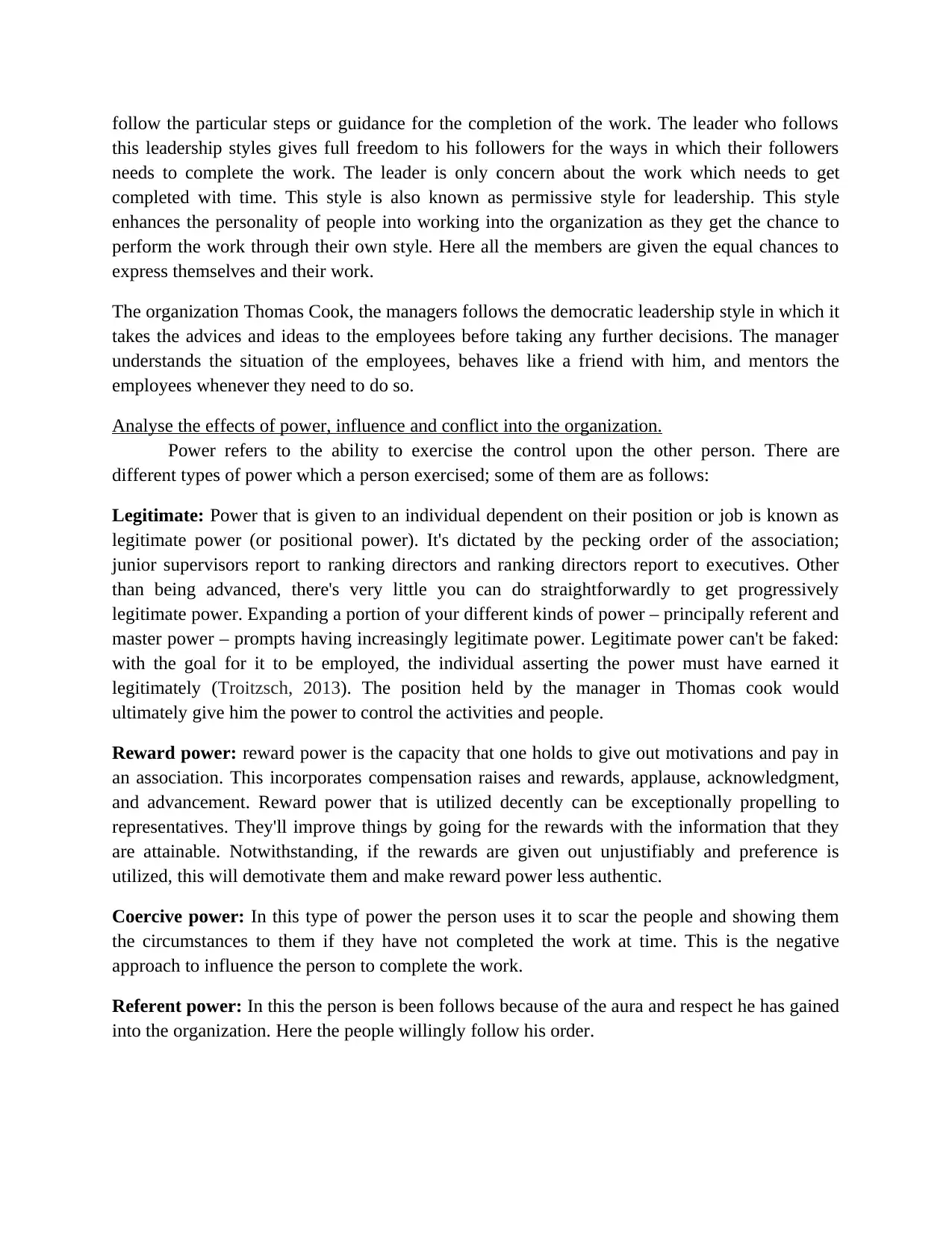
follow the particular steps or guidance for the completion of the work. The leader who follows
this leadership styles gives full freedom to his followers for the ways in which their followers
needs to complete the work. The leader is only concern about the work which needs to get
completed with time. This style is also known as permissive style for leadership. This style
enhances the personality of people into working into the organization as they get the chance to
perform the work through their own style. Here all the members are given the equal chances to
express themselves and their work.
The organization Thomas Cook, the managers follows the democratic leadership style in which it
takes the advices and ideas to the employees before taking any further decisions. The manager
understands the situation of the employees, behaves like a friend with him, and mentors the
employees whenever they need to do so.
Analyse the effects of power, influence and conflict into the organization.
Power refers to the ability to exercise the control upon the other person. There are
different types of power which a person exercised; some of them are as follows:
Legitimate: Power that is given to an individual dependent on their position or job is known as
legitimate power (or positional power). It's dictated by the pecking order of the association;
junior supervisors report to ranking directors and ranking directors report to executives. Other
than being advanced, there's very little you can do straightforwardly to get progressively
legitimate power. Expanding a portion of your different kinds of power – principally referent and
master power – prompts having increasingly legitimate power. Legitimate power can't be faked:
with the goal for it to be employed, the individual asserting the power must have earned it
legitimately (Troitzsch, 2013). The position held by the manager in Thomas cook would
ultimately give him the power to control the activities and people.
Reward power: reward power is the capacity that one holds to give out motivations and pay in
an association. This incorporates compensation raises and rewards, applause, acknowledgment,
and advancement. Reward power that is utilized decently can be exceptionally propelling to
representatives. They'll improve things by going for the rewards with the information that they
are attainable. Notwithstanding, if the rewards are given out unjustifiably and preference is
utilized, this will demotivate them and make reward power less authentic.
Coercive power: In this type of power the person uses it to scar the people and showing them
the circumstances to them if they have not completed the work at time. This is the negative
approach to influence the person to complete the work.
Referent power: In this the person is been follows because of the aura and respect he has gained
into the organization. Here the people willingly follow his order.
this leadership styles gives full freedom to his followers for the ways in which their followers
needs to complete the work. The leader is only concern about the work which needs to get
completed with time. This style is also known as permissive style for leadership. This style
enhances the personality of people into working into the organization as they get the chance to
perform the work through their own style. Here all the members are given the equal chances to
express themselves and their work.
The organization Thomas Cook, the managers follows the democratic leadership style in which it
takes the advices and ideas to the employees before taking any further decisions. The manager
understands the situation of the employees, behaves like a friend with him, and mentors the
employees whenever they need to do so.
Analyse the effects of power, influence and conflict into the organization.
Power refers to the ability to exercise the control upon the other person. There are
different types of power which a person exercised; some of them are as follows:
Legitimate: Power that is given to an individual dependent on their position or job is known as
legitimate power (or positional power). It's dictated by the pecking order of the association;
junior supervisors report to ranking directors and ranking directors report to executives. Other
than being advanced, there's very little you can do straightforwardly to get progressively
legitimate power. Expanding a portion of your different kinds of power – principally referent and
master power – prompts having increasingly legitimate power. Legitimate power can't be faked:
with the goal for it to be employed, the individual asserting the power must have earned it
legitimately (Troitzsch, 2013). The position held by the manager in Thomas cook would
ultimately give him the power to control the activities and people.
Reward power: reward power is the capacity that one holds to give out motivations and pay in
an association. This incorporates compensation raises and rewards, applause, acknowledgment,
and advancement. Reward power that is utilized decently can be exceptionally propelling to
representatives. They'll improve things by going for the rewards with the information that they
are attainable. Notwithstanding, if the rewards are given out unjustifiably and preference is
utilized, this will demotivate them and make reward power less authentic.
Coercive power: In this type of power the person uses it to scar the people and showing them
the circumstances to them if they have not completed the work at time. This is the negative
approach to influence the person to complete the work.
Referent power: In this the person is been follows because of the aura and respect he has gained
into the organization. Here the people willingly follow his order.
Paraphrase This Document
Need a fresh take? Get an instant paraphrase of this document with our AI Paraphraser
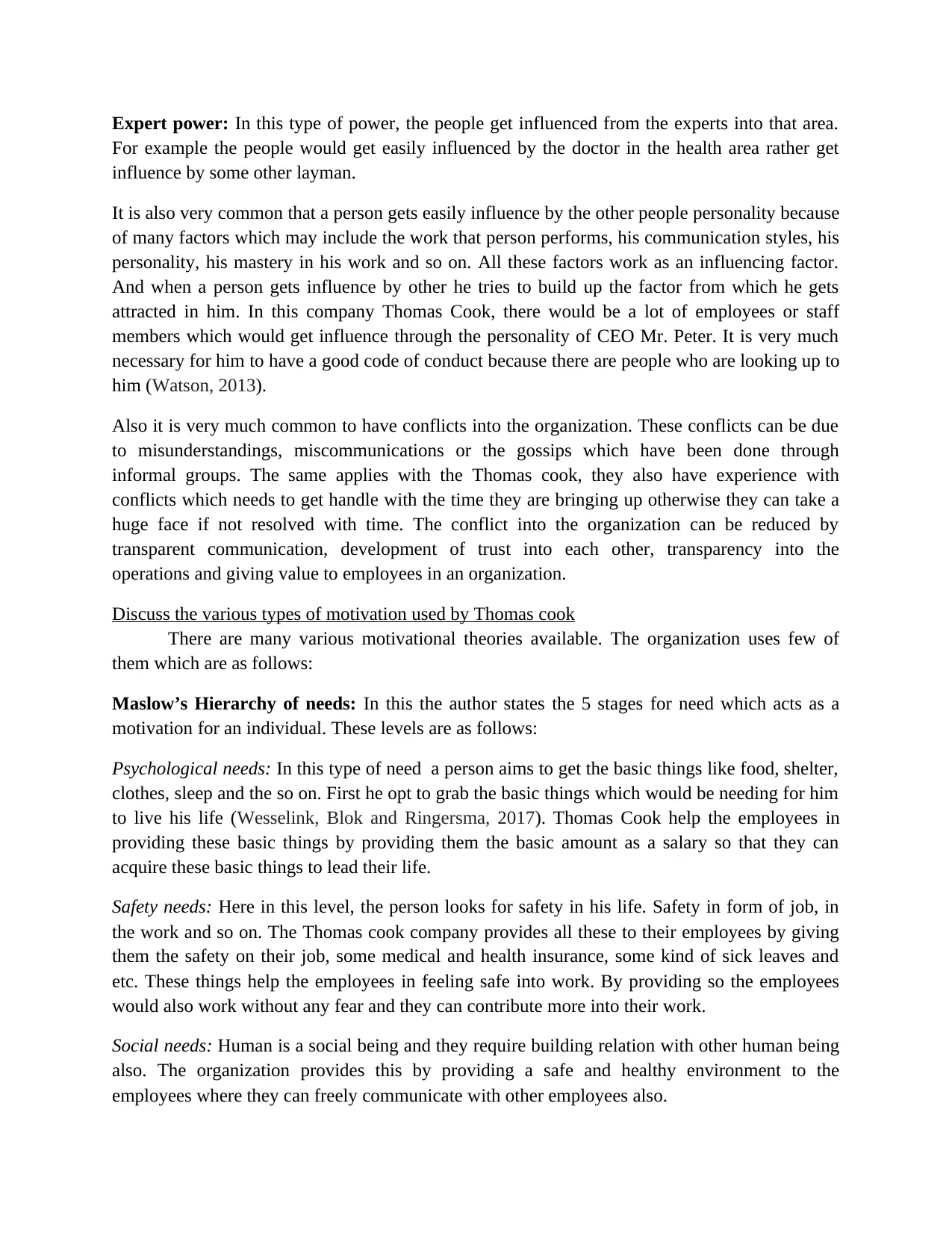
Expert power: In this type of power, the people get influenced from the experts into that area.
For example the people would get easily influenced by the doctor in the health area rather get
influence by some other layman.
It is also very common that a person gets easily influence by the other people personality because
of many factors which may include the work that person performs, his communication styles, his
personality, his mastery in his work and so on. All these factors work as an influencing factor.
And when a person gets influence by other he tries to build up the factor from which he gets
attracted in him. In this company Thomas Cook, there would be a lot of employees or staff
members which would get influence through the personality of CEO Mr. Peter. It is very much
necessary for him to have a good code of conduct because there are people who are looking up to
him (Watson, 2013).
Also it is very much common to have conflicts into the organization. These conflicts can be due
to misunderstandings, miscommunications or the gossips which have been done through
informal groups. The same applies with the Thomas cook, they also have experience with
conflicts which needs to get handle with the time they are bringing up otherwise they can take a
huge face if not resolved with time. The conflict into the organization can be reduced by
transparent communication, development of trust into each other, transparency into the
operations and giving value to employees in an organization.
Discuss the various types of motivation used by Thomas cook
There are many various motivational theories available. The organization uses few of
them which are as follows:
Maslow’s Hierarchy of needs: In this the author states the 5 stages for need which acts as a
motivation for an individual. These levels are as follows:
Psychological needs: In this type of need a person aims to get the basic things like food, shelter,
clothes, sleep and the so on. First he opt to grab the basic things which would be needing for him
to live his life (Wesselink, Blok and Ringersma, 2017). Thomas Cook help the employees in
providing these basic things by providing them the basic amount as a salary so that they can
acquire these basic things to lead their life.
Safety needs: Here in this level, the person looks for safety in his life. Safety in form of job, in
the work and so on. The Thomas cook company provides all these to their employees by giving
them the safety on their job, some medical and health insurance, some kind of sick leaves and
etc. These things help the employees in feeling safe into work. By providing so the employees
would also work without any fear and they can contribute more into their work.
Social needs: Human is a social being and they require building relation with other human being
also. The organization provides this by providing a safe and healthy environment to the
employees where they can freely communicate with other employees also.
For example the people would get easily influenced by the doctor in the health area rather get
influence by some other layman.
It is also very common that a person gets easily influence by the other people personality because
of many factors which may include the work that person performs, his communication styles, his
personality, his mastery in his work and so on. All these factors work as an influencing factor.
And when a person gets influence by other he tries to build up the factor from which he gets
attracted in him. In this company Thomas Cook, there would be a lot of employees or staff
members which would get influence through the personality of CEO Mr. Peter. It is very much
necessary for him to have a good code of conduct because there are people who are looking up to
him (Watson, 2013).
Also it is very much common to have conflicts into the organization. These conflicts can be due
to misunderstandings, miscommunications or the gossips which have been done through
informal groups. The same applies with the Thomas cook, they also have experience with
conflicts which needs to get handle with the time they are bringing up otherwise they can take a
huge face if not resolved with time. The conflict into the organization can be reduced by
transparent communication, development of trust into each other, transparency into the
operations and giving value to employees in an organization.
Discuss the various types of motivation used by Thomas cook
There are many various motivational theories available. The organization uses few of
them which are as follows:
Maslow’s Hierarchy of needs: In this the author states the 5 stages for need which acts as a
motivation for an individual. These levels are as follows:
Psychological needs: In this type of need a person aims to get the basic things like food, shelter,
clothes, sleep and the so on. First he opt to grab the basic things which would be needing for him
to live his life (Wesselink, Blok and Ringersma, 2017). Thomas Cook help the employees in
providing these basic things by providing them the basic amount as a salary so that they can
acquire these basic things to lead their life.
Safety needs: Here in this level, the person looks for safety in his life. Safety in form of job, in
the work and so on. The Thomas cook company provides all these to their employees by giving
them the safety on their job, some medical and health insurance, some kind of sick leaves and
etc. These things help the employees in feeling safe into work. By providing so the employees
would also work without any fear and they can contribute more into their work.
Social needs: Human is a social being and they require building relation with other human being
also. The organization provides this by providing a safe and healthy environment to the
employees where they can freely communicate with other employees also.
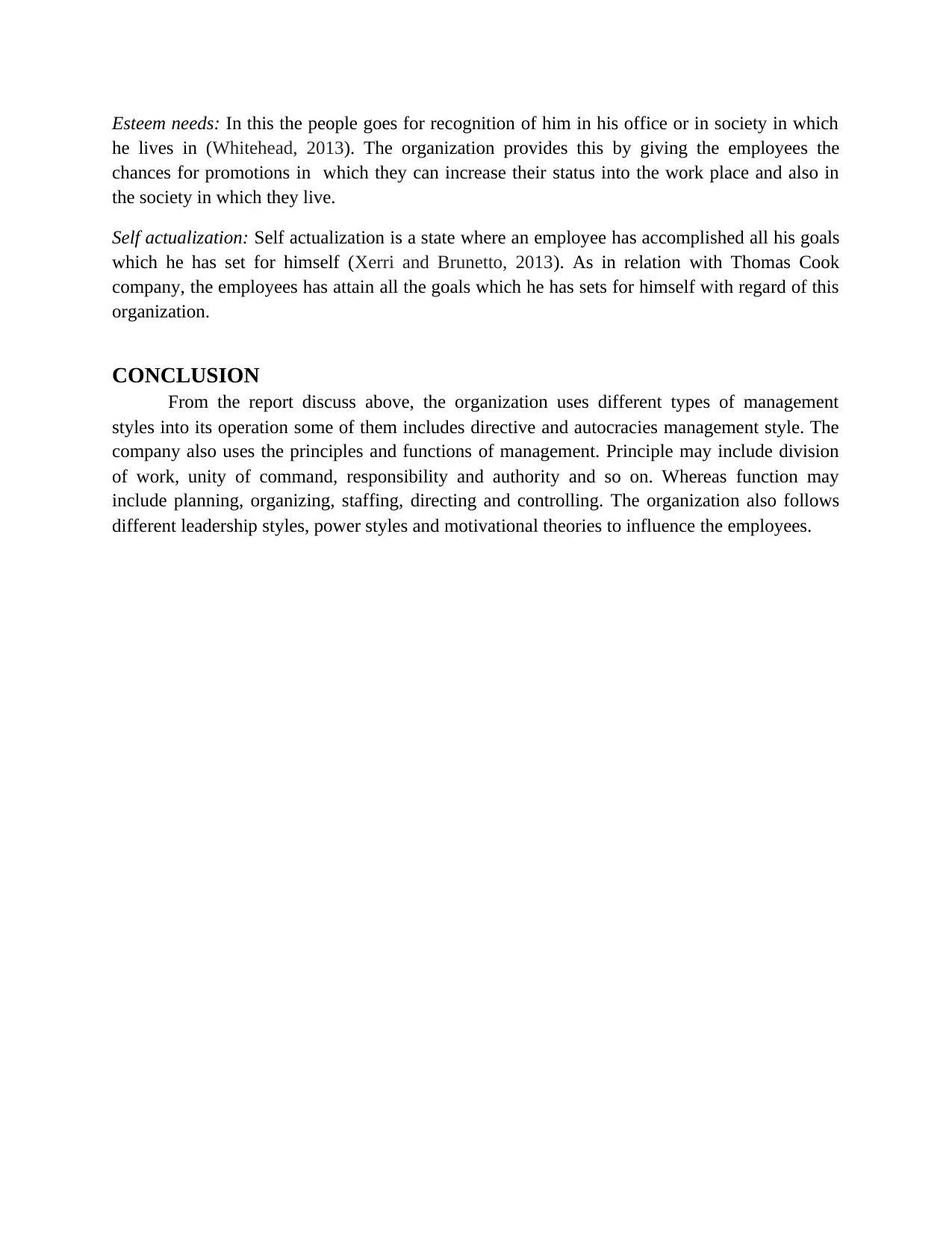
Esteem needs: In this the people goes for recognition of him in his office or in society in which
he lives in (Whitehead, 2013). The organization provides this by giving the employees the
chances for promotions in which they can increase their status into the work place and also in
the society in which they live.
Self actualization: Self actualization is a state where an employee has accomplished all his goals
which he has set for himself (Xerri and Brunetto, 2013). As in relation with Thomas Cook
company, the employees has attain all the goals which he has sets for himself with regard of this
organization.
CONCLUSION
From the report discuss above, the organization uses different types of management
styles into its operation some of them includes directive and autocracies management style. The
company also uses the principles and functions of management. Principle may include division
of work, unity of command, responsibility and authority and so on. Whereas function may
include planning, organizing, staffing, directing and controlling. The organization also follows
different leadership styles, power styles and motivational theories to influence the employees.
he lives in (Whitehead, 2013). The organization provides this by giving the employees the
chances for promotions in which they can increase their status into the work place and also in
the society in which they live.
Self actualization: Self actualization is a state where an employee has accomplished all his goals
which he has set for himself (Xerri and Brunetto, 2013). As in relation with Thomas Cook
company, the employees has attain all the goals which he has sets for himself with regard of this
organization.
CONCLUSION
From the report discuss above, the organization uses different types of management
styles into its operation some of them includes directive and autocracies management style. The
company also uses the principles and functions of management. Principle may include division
of work, unity of command, responsibility and authority and so on. Whereas function may
include planning, organizing, staffing, directing and controlling. The organization also follows
different leadership styles, power styles and motivational theories to influence the employees.
⊘ This is a preview!⊘
Do you want full access?
Subscribe today to unlock all pages.

Trusted by 1+ million students worldwide
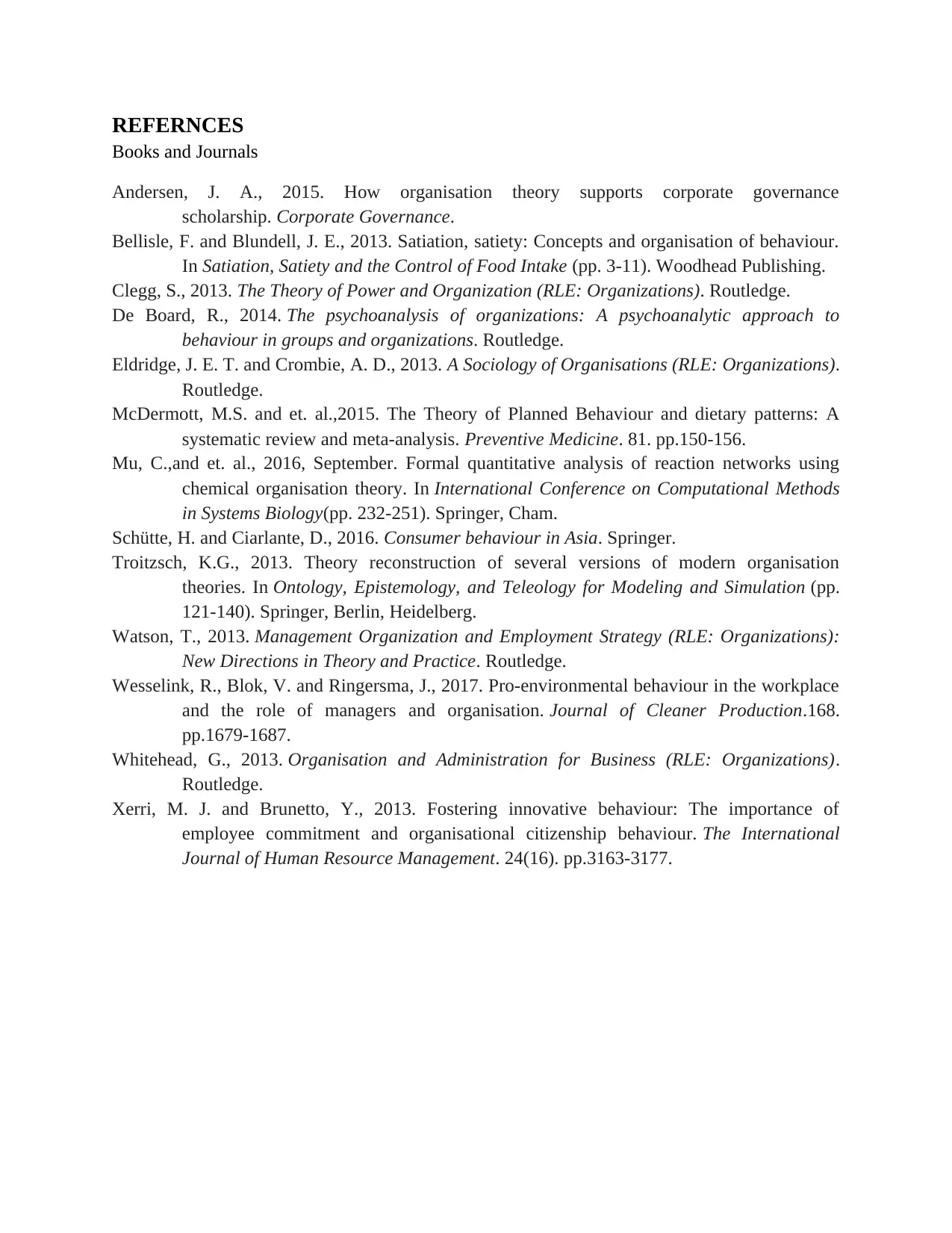
REFERNCES
Books and Journals
Andersen, J. A., 2015. How organisation theory supports corporate governance
scholarship. Corporate Governance.
Bellisle, F. and Blundell, J. E., 2013. Satiation, satiety: Concepts and organisation of behaviour.
In Satiation, Satiety and the Control of Food Intake (pp. 3-11). Woodhead Publishing.
Clegg, S., 2013. The Theory of Power and Organization (RLE: Organizations). Routledge.
De Board, R., 2014. The psychoanalysis of organizations: A psychoanalytic approach to
behaviour in groups and organizations. Routledge.
Eldridge, J. E. T. and Crombie, A. D., 2013. A Sociology of Organisations (RLE: Organizations).
Routledge.
McDermott, M.S. and et. al.,2015. The Theory of Planned Behaviour and dietary patterns: A
systematic review and meta-analysis. Preventive Medicine. 81. pp.150-156.
Mu, C.,and et. al., 2016, September. Formal quantitative analysis of reaction networks using
chemical organisation theory. In International Conference on Computational Methods
in Systems Biology(pp. 232-251). Springer, Cham.
Schütte, H. and Ciarlante, D., 2016. Consumer behaviour in Asia. Springer.
Troitzsch, K.G., 2013. Theory reconstruction of several versions of modern organisation
theories. In Ontology, Epistemology, and Teleology for Modeling and Simulation (pp.
121-140). Springer, Berlin, Heidelberg.
Watson, T., 2013. Management Organization and Employment Strategy (RLE: Organizations):
New Directions in Theory and Practice. Routledge.
Wesselink, R., Blok, V. and Ringersma, J., 2017. Pro-environmental behaviour in the workplace
and the role of managers and organisation. Journal of Cleaner Production.168.
pp.1679-1687.
Whitehead, G., 2013. Organisation and Administration for Business (RLE: Organizations).
Routledge.
Xerri, M. J. and Brunetto, Y., 2013. Fostering innovative behaviour: The importance of
employee commitment and organisational citizenship behaviour. The International
Journal of Human Resource Management. 24(16). pp.3163-3177.
Books and Journals
Andersen, J. A., 2015. How organisation theory supports corporate governance
scholarship. Corporate Governance.
Bellisle, F. and Blundell, J. E., 2013. Satiation, satiety: Concepts and organisation of behaviour.
In Satiation, Satiety and the Control of Food Intake (pp. 3-11). Woodhead Publishing.
Clegg, S., 2013. The Theory of Power and Organization (RLE: Organizations). Routledge.
De Board, R., 2014. The psychoanalysis of organizations: A psychoanalytic approach to
behaviour in groups and organizations. Routledge.
Eldridge, J. E. T. and Crombie, A. D., 2013. A Sociology of Organisations (RLE: Organizations).
Routledge.
McDermott, M.S. and et. al.,2015. The Theory of Planned Behaviour and dietary patterns: A
systematic review and meta-analysis. Preventive Medicine. 81. pp.150-156.
Mu, C.,and et. al., 2016, September. Formal quantitative analysis of reaction networks using
chemical organisation theory. In International Conference on Computational Methods
in Systems Biology(pp. 232-251). Springer, Cham.
Schütte, H. and Ciarlante, D., 2016. Consumer behaviour in Asia. Springer.
Troitzsch, K.G., 2013. Theory reconstruction of several versions of modern organisation
theories. In Ontology, Epistemology, and Teleology for Modeling and Simulation (pp.
121-140). Springer, Berlin, Heidelberg.
Watson, T., 2013. Management Organization and Employment Strategy (RLE: Organizations):
New Directions in Theory and Practice. Routledge.
Wesselink, R., Blok, V. and Ringersma, J., 2017. Pro-environmental behaviour in the workplace
and the role of managers and organisation. Journal of Cleaner Production.168.
pp.1679-1687.
Whitehead, G., 2013. Organisation and Administration for Business (RLE: Organizations).
Routledge.
Xerri, M. J. and Brunetto, Y., 2013. Fostering innovative behaviour: The importance of
employee commitment and organisational citizenship behaviour. The International
Journal of Human Resource Management. 24(16). pp.3163-3177.
1 out of 10
Related Documents
Your All-in-One AI-Powered Toolkit for Academic Success.
+13062052269
info@desklib.com
Available 24*7 on WhatsApp / Email
![[object Object]](/_next/static/media/star-bottom.7253800d.svg)
Unlock your academic potential
Copyright © 2020–2025 A2Z Services. All Rights Reserved. Developed and managed by ZUCOL.





